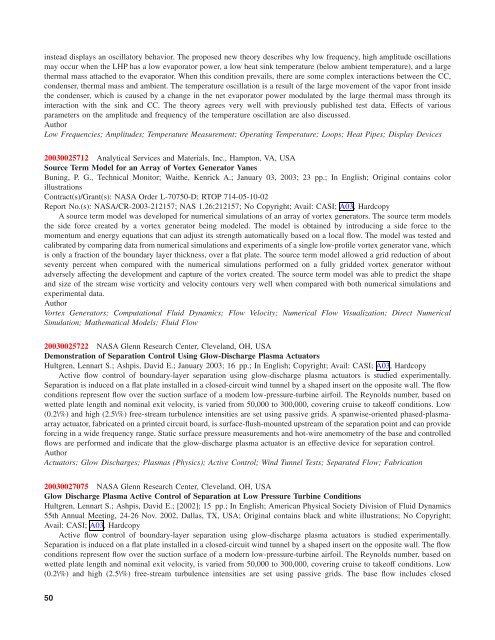You also want an ePaper? Increase the reach of your titles
YUMPU automatically turns print PDFs into web optimized ePapers that Google loves.
instead displays an oscillatory behavior. The proposed new theory describes why low frequency, high amplitude oscillations<br />
may occur when the LHP has a low evaporator power, a low heat sink temperature (below ambient temperature), and a large<br />
thermal mass attached to the evaporator. When this condition prevails, there are some complex interactions between the CC,<br />
condenser, thermal mass and ambient. The temperature oscillation is a result of the large movement of the vapor front inside<br />
the condenser, which is caused by a change in the net evaporator power modulated by the large thermal mass through its<br />
interaction with the sink and CC. The theory agrees very well with previously published test data. Effects of various<br />
parameters on the amplitude and frequency of the temperature oscillation are also discussed.<br />
Author<br />
Low Frequencies; Amplitudes; Temperature Measurement; Operating Temperature; Loops; Heat Pipes; Display Devices<br />
20030025712 Analytical Services and Materials, Inc., Hampton, VA, USA<br />
Source Term Model for an Array of Vortex Generator Vanes<br />
Buning, P. G., Technical Monitor; Waithe, Kenrick A.; January 03, 2003; 23 pp.; In English; Original contains color<br />
illustrations<br />
Contract(s)/Grant(s): NASA Order L-70750-D; RTOP 714-05-10-02<br />
Report No.(s): NASA/CR-2003-212157; NAS 1.26:212157; No Copyright; Avail: CASI; A03, Hardcopy<br />
A source term model was developed for numerical simulations of an array of vortex generators. The source term models<br />
the side force created by a vortex generator being modeled. The model is obtained by introducing a side force to the<br />
momentum and energy equations that can adjust its strength automatically based on a local flow. The model was tested and<br />
calibrated by comparing data from numerical simulations and experiments of a single low-pro<strong>file</strong> vortex generator vane, which<br />
is only a fraction of the boundary layer thickness, over a flat plate. The source term model allowed a grid reduction of about<br />
seventy percent when compared with the numerical simulations performed on a fully gridded vortex generator without<br />
adversely affecting the development and capture of the vortex created. The source term model was able to predict the shape<br />
and size of the stream wise vorticity and velocity contours very well when compared with both numerical simulations and<br />
experimental data.<br />
Author<br />
Vortex Generators; Computational Fluid Dynamics; Flow Velocity; Numerical Flow Visualization; Direct Numerical<br />
Simulation; Mathematical Models; Fluid Flow<br />
20030025722 NASA Glenn Research Center, Cleveland, OH, USA<br />
Demonstration of Separation Control Using Glow-Discharge Plasma Actuators<br />
Hultgren, Lennart S.; Ashpis, David E.; January 2003; 16 pp.; In English; Copyright; Avail: CASI; A03, Hardcopy<br />
Active flow control of boundary-layer separation using glow-discharge plasma actuators is studied experimentally.<br />
Separation is induced on a flat plate installed in a closed-circuit wind tunnel by a shaped insert on the opposite wall. The flow<br />
conditions represent flow over the suction surface of a modem low-pressure-turbine airfoil. The Reynolds number, based on<br />
wetted plate length and nominal exit velocity, is varied from 50,000 to 300,000, covering cruise to takeoff conditions. Low<br />
(0.2\%) and high (2.5\%) free-stream turbulence intensities are set using passive grids. A spanwise-oriented phased-plasmaarray<br />
actuator, fabricated on a printed circuit board, is surface-flush-mounted upstream of the separation point and can provide<br />
forcing in a wide frequency range. Static surface pressure measurements and hot-wire anemometry of the base and controlled<br />
flows are performed and indicate that the glow-discharge plasma actuator is an effective device for separation control.<br />
Author<br />
Actuators; Glow Discharges; Plasmas (Physics); Active Control; Wind Tunnel Tests; Separated Flow; Fabrication<br />
20030027075 NASA Glenn Research Center, Cleveland, OH, USA<br />
Glow Discharge Plasma Active Control of Separation at Low Pressure Turbine Conditions<br />
Hultgren, Lennart S.; Ashpis, David E.; [2002]; 15 pp.; In English; American Physical Society Division of Fluid Dynamics<br />
55th Annual Meeting, 24-26 Nov. 2002, Dallas, TX, USA; Original contains black and white illustrations; No Copyright;<br />
Avail: CASI; A03, Hardcopy<br />
Active flow control of boundary-layer separation using glow-discharge plasma actuators is studied experimentally.<br />
Separation is induced on a flat plate installed in a closed-circuit wind tunnel by a shaped insert on the opposite wall. The flow<br />
conditions represent flow over the suction surface of a modern low-pressure-turbine airfoil. The Reynolds number, based on<br />
wetted plate length and nominal exit velocity, is varied from 50,000 to 300,000, covering cruise to takeoff conditions. Low<br />
(0.2\%) and high (2.5\%) free-stream turbulence intensities are set using passive grids. The base flow includes closed<br />
50
















